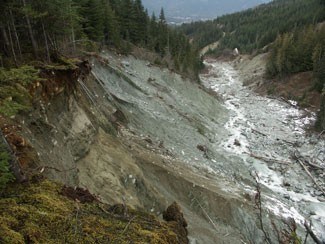A just released government report confirms that Whistler is at risk from a debris flood if a landslide above the village occurs.
And the author, Vancouver based EBA Engineering, is recommending that a debris basin be built, at a cost of several million dollars, to protect North America’s No. 1 ski resort.
"(The slide’s) threat lies in its potential to dam Fitzsimmons Creek," states the report.
"The inevitable overtopping and breaching of such a dam could result in a flood or creation of debris flow which could have a severe impact on Whistler."
Such a debris flow would cascade down the creek into the day-skier parking lots and the public bus loop.
The report warns that choosing to do nothing but continue with current practices: "…fails to reduce the risk of loss of life or property due to a known hazard. This in turn leads to the potential for increased liability on the part of (Whistler) or significant negative publicity in the pre-Olympic period."
The report describes several levels of risk from the slump on Whistler Mountain. The authors found that the chance of the whole slump letting go, bringing close to 1 million cubic metres of debris into the village is, very low.
However, there are risks associated with the continued degradation of the slump and its continuous sloughing off of gravel into Fitzsimmons Creek. That is one reason why, said Bob Bugslag, director of the Provincial Emergency Program, the province has already stepped in and spent more than $200,000 on gravel removal from the lower Fitzsimmons Creek area.
"As long as you maintain the channel capacity then you mitigate those risks and they go from low to very low," he said.
Part of addressing the problem is understanding the nature of the risk and the trigger mechanisms said Bugslag, and that is where the report allows all the stakeholders to move forward.
"As long as you are diligent in terms of your monitoring program and you understand the natural trigger mechanism – say if you’ve got snowmelt and a week of heavy rain like we had in January of this year or 2003 – then you can put programs in place that will safeguard your population.
"In this case safeguarding the parking lot, so you may close it in those instances, so you develop an emergency strategy that addresses that specific hazard."
Bugslag added that Land and Water B.C. has engaged a second company to draw up conceptual designs for a catch basin, though there is no word yet on when the work might begin.
RMOW spokeswoman Diana Waltmann said talks with the government are gearing up now that the report, commissioned last summer by Land and Water B.C., is complete.
"Now we have these solutions so it is time to discuss where is the money coming from for a catch basin if we go ahead with that and so on," she said.
The government also announced some money for the project as part of a new $1.5 million natural hazard mitigation fund.
Debate over what risk, if any, the Fitzsimmons slump poses to the village has been going on for over a decade. The municipality, which monitors the slump on an on-going basis, has always maintained that the risk of a large event is low. But in recent months Squamish engineer Frank Baumann has been calling for action before lives are lost.
"The EBA report is a good report that completely validates all the previous reports and concerns that have been expressed that the Fitzsimmons slump is a major geologic hazard that puts people in the day skier parking lots at risk and is creating unacceptable environmental impacts, and therefore must be dealt with as soon as possible," he said.
"Indirectly, it is also a damning indictment of the Resort Municipality of Whistler's lack of action on dealing with this major public hazard, and their many years of trying to downplay or ignore the problem."
While praising the government in finally recognizing the hazard and setting a plan in motion to deal with it Baumann now wants to see community discussion on proposed solutions.
He believes a by-pass channel, rather than a catch basin, is the solution as it would cost millions less, lower the sediment in the creek, which would be good for fish habitat and snowmaking, and require less on-going upkeep.
The EBA report steers away from that solution over concerns about how a by-pass channel would affect another slump in the Fitzsimmons Creek area.
But Baumann said extensive studies done by Ledcor, which is considering building an independent power project on the creek, found the risk of affecting the second slump to be negligible.
The Fitzsimmons slump moves an average of several centimetres a year. The municipality has recorded four major movements in the past 26 years. A flood in 1991 caused an estimated $2.1 million in damages.
In the short term EBA Engineering wants to see enhanced monitoring of Fitzsimmons Creek and the slump, which lies about 2 kilometres upstream of the village, a public notification system put in place, and continued dredging of the dyked creek in the village area to remove gravel swept down as the toe of the slump continues to erode.
At times of high risk, such as non-winter heavy rain events, it suggests that the day skier parking lots be closed to the public.




